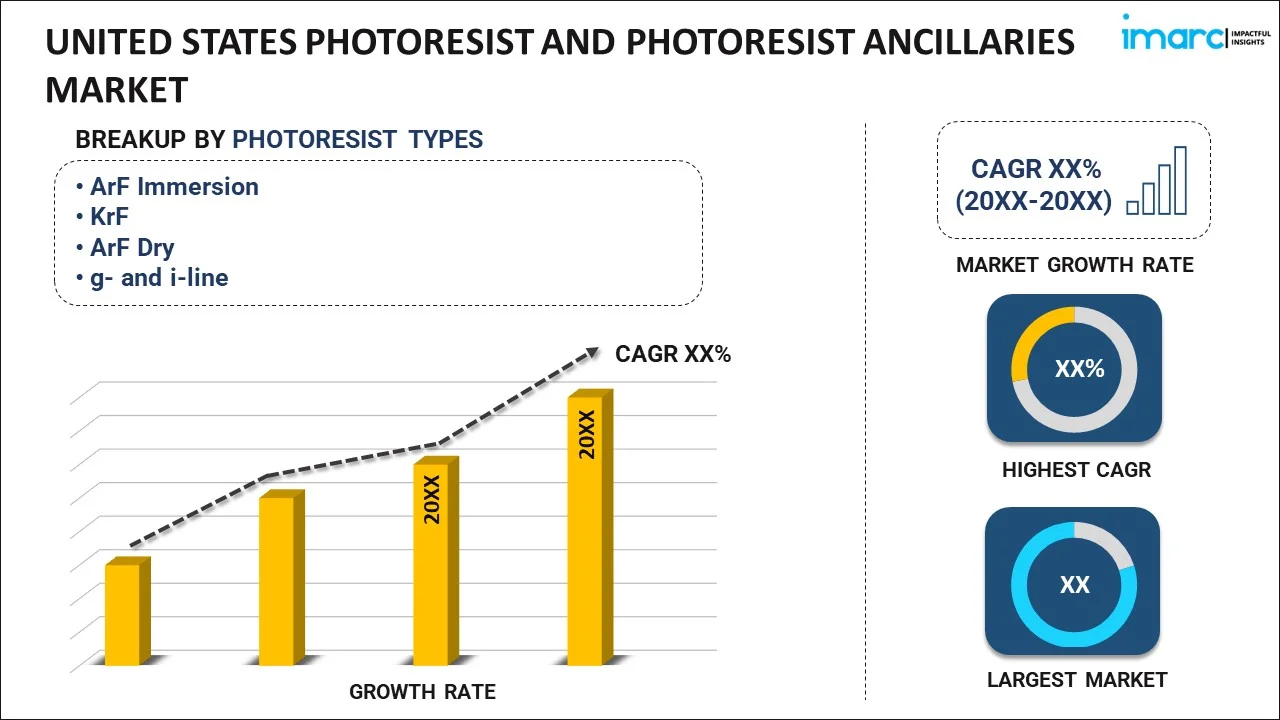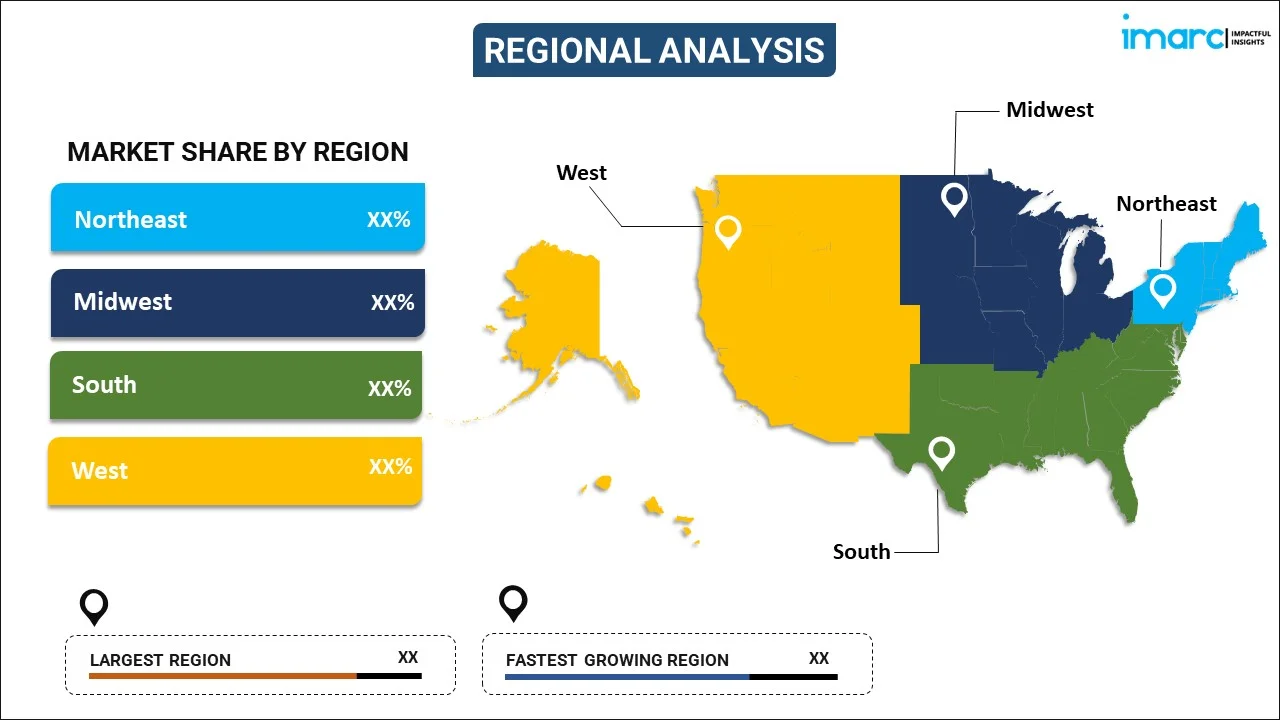
United States Photoresist and Photoresist Ancillaries Market Report by Photoresist Type (ArF Immersion, KrF, ArF Dry, g- and i-line), Photoresist Ancillaries Type (Anti-Reflective Coatings, Remover, Developer, and Others), Application (Semiconductors & ICS, LCDs, Printed Circuit Boards, and Others), and Region 2025-2033
Market Overview:
The United States photoresist and photoresist ancillaries market size reached USD 1,000.0 Million in 2024. Looking forward, IMARC Group expects the market to reach USD 1,511.5 Million by 2033, exhibiting a growth rate (CAGR) of 4.46% during 2025-2033.
|
Report Attribute
|
Key Statistics
|
|---|---|
|
Base Year
|
2024 |
|
Forecast Years
|
2025-2033
|
|
Historical Years
|
2019-2024
|
| Market Size in 2024 | USD 1,000.0 Million |
| Market Forecast in 2033 | USD 1,511.5 Million |
| Market Growth Rate (2025-2033) | 4.46% |
A photoresist is a photosensitive material that can change its chemical structure when exposed to ultraviolet light. Photoresist ancillaries are supporting products that are used to improve the efficiency and resolution of the photolithography or photoengraving process. Resins with the desired solvent and a photo active generator (PAG) compound are the basic raw materials used to manufacture photoresist chemicals and ancillaries. Positive photoresists are soluble, while negative photoresists become insoluble and cross-linked when exposed to UV light. They are used in flat panel displays and wiring configurations for the manufacturing of multi-layer semiconductors.
The United States photoresist and photoresist ancillaries market is primarily driven by the flourishing semiconductor industry. The trend of miniaturization in the semiconductor industry has enabled the development of advanced technologies that now form the backbone of the modern electronics industry. This has been supported by the development of polymer-based photoresist materials and consequent advances in the photolithography process. These advances have led to the evolution of microfabrication technology resulting in higher-level integration and downscaling of semiconductor ICs. Besides this, the growing demand for advanced gadgets, such as computers, laptops, phones, and other household appliances, has led to increased use of raw materials such as photoresist and photoresist ancillaries. Moreover, the increasing research and development (R&D) activities, technological advancements in the display technology and the expanding semiconductor industry are some of the other factors contributing to the market.
Key Market Segmentation:
IMARC Group provides an analysis of the key trends in each sub-segment of the United States photoresist and photoresist ancillaries market report, along with forecasts at the country and regional level from 2025-2033. Our report has categorized the market based on photoresist type, photoresist ancillaries type and application.
Breakup by Photoresist Type:

- ArF Immersion
- KrF
- ArF Dry
- g- and i-line
Breakup by Photoresist Ancillaries Type:
- Anti-Reflective Coatings
- Remover
- Developer
- Others
Breakup by Application:
- Semiconductors & ICS
- LCDs
- Printed Circuit Boards
- Others
Breakup by Region:

- Northeast
- Midwest
- South
- West
Competitive Landscape:
The competitive landscape of the industry has also been examined along with the profiles of the key players.
Report Coverage:
| Report Features | Details |
|---|---|
| Base Year of the Analysis | 2024 |
| Historical Period | 2019-2024 |
| Forecast Period | 2025-2033 |
| Units | Million USD |
| Segment Coverage | Photoresist Type, Photoresist Ancillaries Type, Application, Region |
| Region Covered | Northeast, Midwest, South, West |
| Customization Scope | 10% Free Customization |
| Post-Sale Analyst Support | 10-12 Weeks |
| Delivery Format | PDF and Excel through Email (We can also provide the editable version of the report in PPT/Word format on special request) |
Key Questions Answered in This Report
The United States photoresist and photoresist ancillaries market was valued at USD 1,000.0 Million in 2024.
We expect the United States photoresist and photoresist ancillaries market to exhibit a CAGR of 4.46% during 2025-2033.
The rising adoption of photoresist and photoresist ancillaries in manufacturing several consumer devices, such as laptops, smartphones, and multimedia players, is currently driving the United States photoresist and photoresist ancillaries market.
The sudden outbreak of the COVID-19 pandemic had led to the implementation of stringent lockdown regulations across the nation resulting in temporary closure of numerous end use industries for photoresist and photoresist ancillaries.
Based on the photoresist type, the United States photoresist and photoresist ancillaries market can be segmented into ArF immersion, KrF, ArF dry, and g- and i-line. Currently, ArF immersion holds the majority of the total market share.
Based on the photoresist ancillaries type, the United States photoresist and photoresist ancillaries market has been divided into anti-reflective coatings, remover, developer, and others. Among these, anti-reflective coatings exhibit a clear dominance in the market.
Based on the application, the United States photoresist and photoresist ancillaries market can be categorized into semiconductors & ICs, LCDs, printed circuit boards, and others. Currently, semiconductors & ICs account for the largest market share.
On a regional level, the market has been classified into Northeast, Midwest, South, and West, where South currently dominates the United States market.
Need more help?
- Speak to our experienced analysts for insights on the current market scenarios.
- Include additional segments and countries to customize the report as per your requirement.
- Gain an unparalleled competitive advantage in your domain by understanding how to utilize the report and positively impacting your operations and revenue.
- For further assistance, please connect with our analysts.
 Inquire Before Buying
Inquire Before Buying
 Speak to an Analyst
Speak to an Analyst
 Request Brochure
Request Brochure
 Request Customization
Request Customization




.webp)




.webp)












